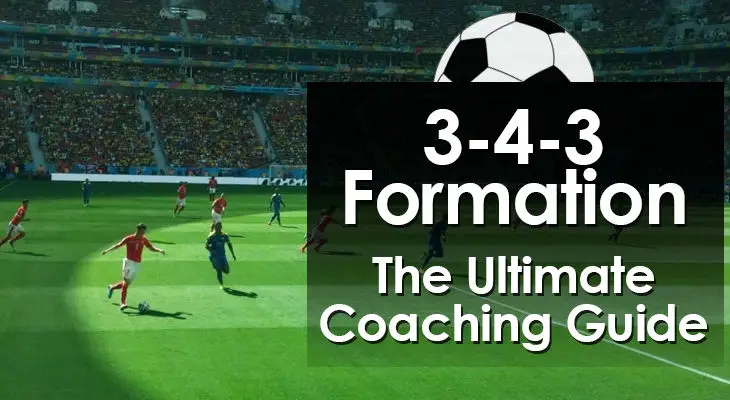3-4-3 Formation – The Ultimate Coaching Guide
Soccer formations like the 3-4-3 formation are constantly falling in and out of fashion as tactical innovations lead teams to vary their approach.
The beauty of soccer is that there is no single way to play.
For the 3-4-3 formation to work, you need tactically astute players who fully understand their role on the team.
As an unorthodox shape, your players must be flexible and know how to respond both with and without the ball.
Not every team has the personnel to play the 3-4-3 formation as it relies on stamina, tactical discipline, and a high level of technical players to make it work.
But if your team can adapt, this is a powerful tactical setup, especially going forward.
Below, I explain the key aspects of a 3-4-3 formation and give you the strategic tools to implement it successfully with your team.
What is a 3-4-3 Formation?
Back three’s have been relatively common in soccer for decades.
However, in recent years, they’ve become increasingly popular among the elite teams, with Pep Guardiola, Antonio Conte, and even Jurgen Klopp electing this approach.
That said, not many coaches opt for a 3-4-3, with the main reason being that it commits a lot of players forward, somewhat negating the defensive base.
But if you look beyond the shape on a tactics board, you’ll quickly realize its potential in attack and defense.
The 3-4-3 formation is extremely versatile and can be adapted to a wide range of tactics.
Furthermore, it allows you to be tactically versatile in the game and shift between shapes during transitions.
Multiple Variations
In the standard set-up, the 3-4-3 formation consists of a back three, wingbacks, two center midfielders, and a narrow front three.
The three-player backline functions as any other back three, as do the wingbacks and midfielders.
However, the way coaches set up the front three can vary significantly.
A popular approach is to play with two number 10s behind a lone striker.
If you have goalscoring wingers, you could deploy a false 9 with more advanced wingers on either side.
Or, if you make some midfield adjustments (diamond), you could set out with a modern front three with two wingers and a center forward.
In the 3-4-3 formation, individual responsibilities and instructions are critical.
Now, let’s take a more in-depth look at the strengths and weaknesses.
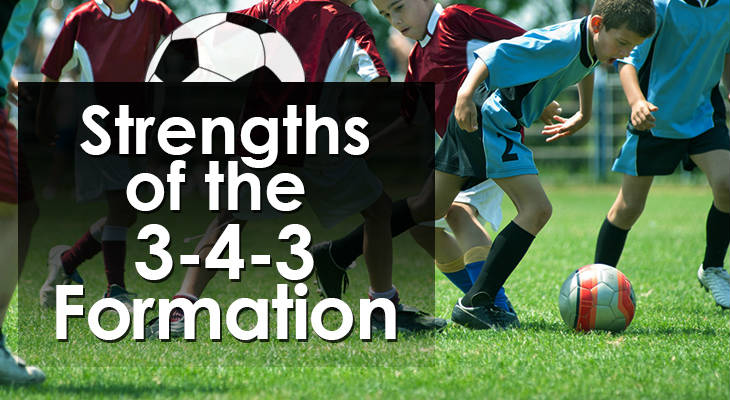
3-4-3 Formation Strengths
#1. Range of Attacking Options
With three forwards and four midfielders, there are huge possibilities when you attack.
The sheer numbers allow for fluidity and creativity which can unlock any defense.
When executed correctly, the 3-4-3 formation can also pin back the opposition, limiting their potency in attack.
Depending on your opponents and what strategies are working, you can choose to go direct, play on the counter, get the ball out wide, or penetrate through the middle.
You’re spoilt for choice in terms of offensive strategy.
#2. Balanced Shape
Along with attacking flair and defensive solidity, the 3-4-3 formation also provides significant width.
The wingbacks are primarily responsible for adding numbers to the wide areas.
And, regardless of whether you set up with two number 10s or wingers, there are ample numbers to fill these spaces.
Overall, there are clusters of players in every part of the field, giving the formation good balance.
#3. Tactical Flexibility
As I alluded to earlier, the 3-4-3 formation is tactically flexible, especially in the midfield and forward lines, giving you plenty of variations to choose from.
Furthermore, you can switch to a different formation seamlessly by adjusting one or two players.
Because of the balance that this formation offers, you can also be tactically flexible in terms of in-game strategy.
The roles of the wingbacks are perhaps the biggest influencers over how your team plays.
For example, if you want to go more defensive, pull the wingbacks into the back.
For a more attacking approach, instruct them to push upfield and join the offense where possible.
#4. Strong Against Defensive Teams
The 3-4-3 formation is a great option against a defensive team or a low block.
With three attackers, two center midfielders, and wingbacks on either flank, you can sustain attacks for long periods.
By playing the ball across the field in front of the low block, you move the defense around, wear them down, and eventually create options.
The key to breaking down the opposition is quick passing, switches of play, and good movement, all of which are seamless in a 3-4-3.
#5. Easy to Create Overloads
Most modern teams adopt a possession-based, build-from-the-back style of play.
One of the most effective ways to progress the ball in this strategy is to create numerical advantages or overloads through the thirds.
The spacing and positioning of players in a 3-4-3 mean you can create overloads centrally and along the wings.
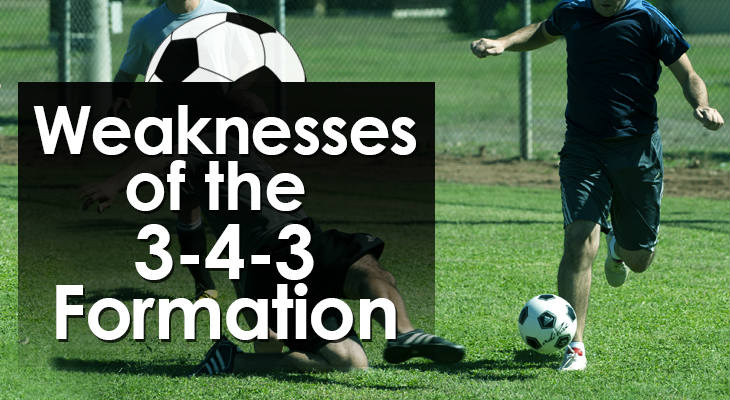
3-4-3 Formation Weaknesses
#1. Demanding in All Positions
The main drawback of playing in a 3-4-3 formation is that it is demanding in all positions.
Its shape allows for attacking fluidity but without skillful players, your team will struggle to keep and progress the ball.
There is little defensive cover, especially in central areas so all players are expected to fulfill their roles to a tee.
Because of the spacing across the field, players in all positions are required to work hard.
High-level stamina is essential in most positions, apart from the center backs.
#2. Can Leave Openings at the Back
Most modern formations use defensive midfielders to shield the backline and cut out passing lanes between the lines.
While the back three gives the team a strong defensive base, spaces can open up between the backline and midfield.
More so, when the wingbacks get forward, they leave a lot of space in behind for the opposition to exploit.
#3. Vulnerable on the Wings
When you look at the 3-4-3 on paper, the obvious vulnerabilities are on the wing.
The top-heavy setup means that the defense can be left open at times.
Since the backline consists of three central defenders, wingers can get enjoyment along the sidelines.
The main opportunities come in transition when the wingbacks are in advanced positions.
#4. Requires Specialist Wingbacks
Wingbacks are unique players that excel in attacking and defensive scenarios.
They’re not only required to shut down the opposition winger, but they’re also expected to contribute quality in attack.
Wingbacks must be fast, strong, defensively sound, and dangerous going forward.
Not many players have the stamina or skill set to fulfill the role.
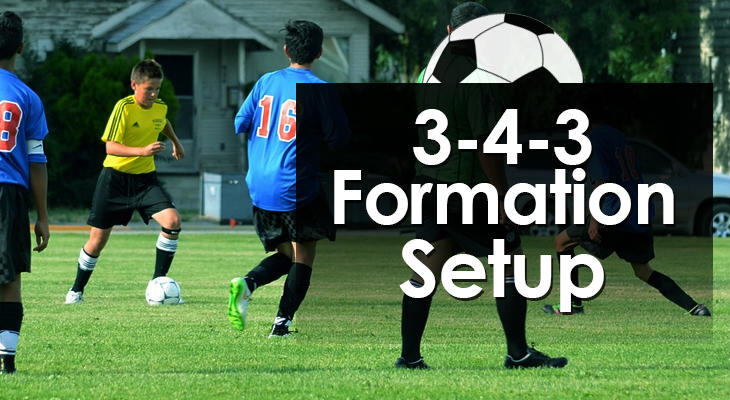
How to Play the 3-4-3 Formation
The 3-4-3 formation is a high-risk, high-reward shape.
With the right players, your team can be a goalscoring machine.
However, it’s important to learn how the formation ticks and the most effective tactics in attack and defense.
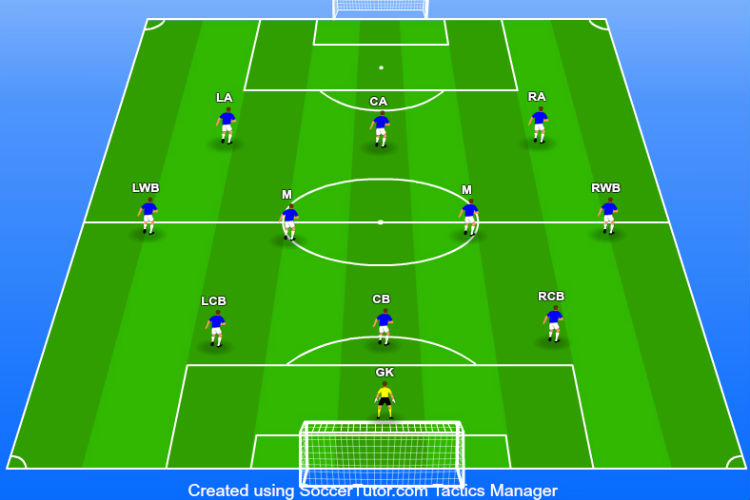
3-4-3 Formation Setup
As discussed, there are several ways to set out your team in a 3-4-3 formation.
Yet still, at its core, it consists of three banks of players:
- Back three (all center backs)
- Middle four (usually two center backs and two center midfielders)
- Front three (usually two number 10s and a striker)
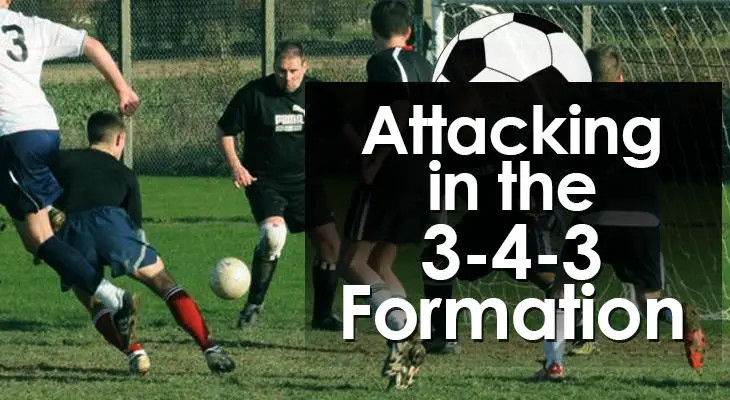
Attacking in the 3-4-3 Formation
The 3-4-3 gives your teams a lot of attacking options.
Although you may focus primarily on one or two, it’s important to know and understand all of its threats.
This ensures you can get the most out of the shape, even when things aren’t going your way.
Below, are three simple but effective strategies to help you attack with fluidity in a 3-4-3 formation.
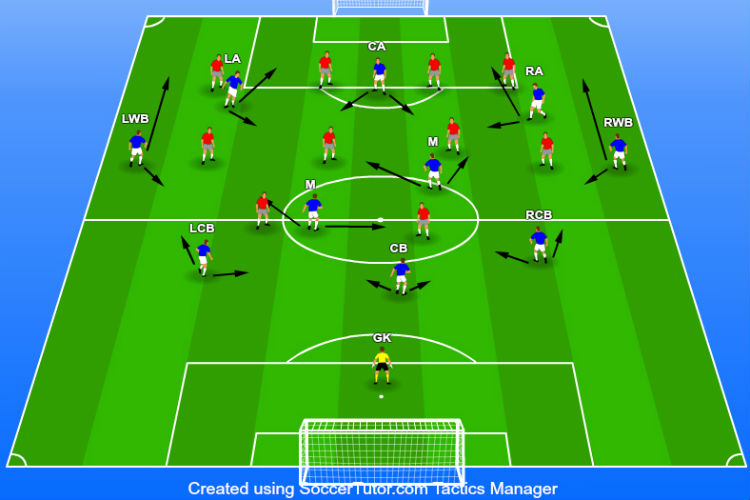
1. Create from the Wings
With such an attacking formation, your opponents are likely to retreat into a compact shape, looking to counterattack.
One of the best ways to break through a tight defense is to spread the ball wide and create from the wings.
Fortunately, the 3-4-3 allows you to commit numbers to the flanks where you can create high-percentage scoring opportunities.
In possession, the wingbacks should bomb forward, whitening their cleats along the sideline.
This stretches the opposition as wide as possible, creating more space for attackers to run into.
One of the number 10s can support the wingback, offering link-up passes, dummy runs, overlaps, and underlaps.
The main idea here is to create overloads and open up avenues to the byline for the wingback or number 10 to make dangerous crosses.
Alternatively, they can play quick passes to skip by the defenders and get into the box directly.
With crosses into the box from the wide forward or the wingback, the opposite wide forward, the central striker, and the attacking midfielder should all make themselves available in the box.
2. Play Through the 10s
With two number 10s leading the attack, it’s imperative that you use them.
Number 10s or center attacking midfielders, are generally the most creative forwards on a team and are largely responsible for attacking play.
Playing between the lines of defense and midfield, they’re difficult to pick up, unless your opponents have two defensive midfielders.
So, when you’re in possession, try to feed the 10s early and often.
They can work with the striker and wingbacks to instigate attacks and create chances.
3. Dominate the Ball
The 3-4-3 formation commits seven 70% of the outfield players to the midfield and forward line.
This allows you to dominate possession and keep the ball for long periods.
There should always be options available and this helps keep possession in the opposition half.
By controlling possession, the team can work their way forward, overload the opposition and create goal-scoring opportunities.
It’s important that your team keeps possession with a purpose.
This means switching the ball from one side to the other, playing probing passes forward, and looking to create chances when a gap opens up.
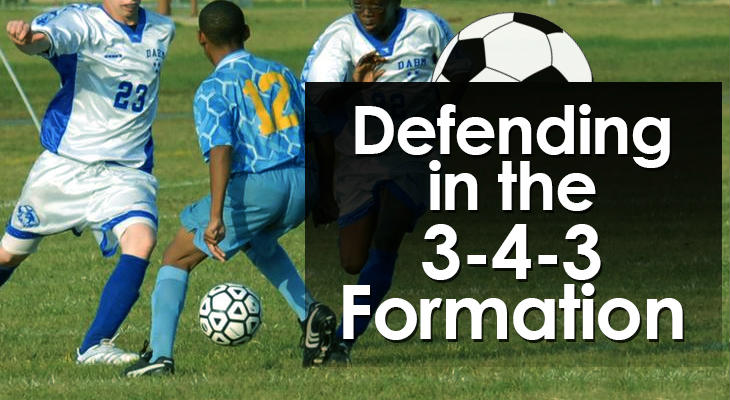
Defending in the 3-4-3 Formation
The 3-4-3 formation is designed to get players forward and attack.
Naturally, this means it has its defensive frailties, as noted earlier in the weaknesses section.
So, to prevent your opponents from taking advantage of these weaknesses, you’ll need a sound defensive strategy.
Here are some tips on how to do so.
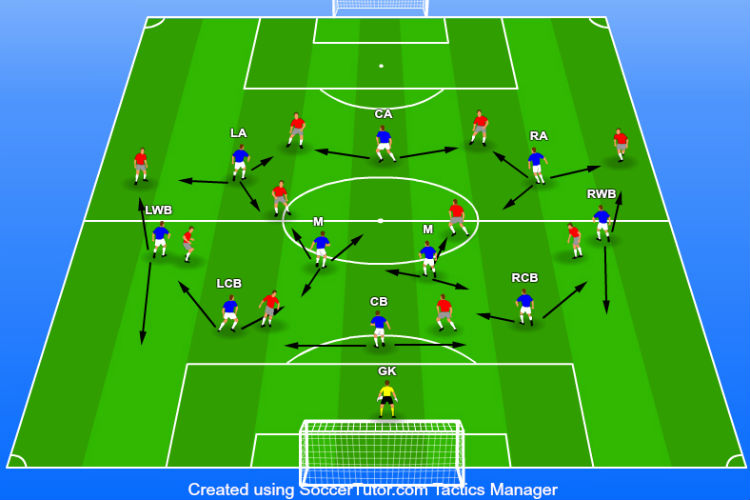
1. Press from the Front
The 3-4-3 is a perfect formation for a high press.
With three attackers, you can pressurize the opponent’s backline when they’re on the ball, looking to intercept passes or force them into mistakes.
Since this formation also has width, it’s best to push the opposition to the wings, then close them down.
This approach helps to keep the opposition hemmed in their half and the team must aim to control possession and not lose the ball.
Defensively vulnerable with only three at the back, the forwards must be energetic and defend from the front.
2. Compress Centrally
If your opponents manage to break through the front press, it’s important that your team retreats and compresses quickly.
The wingbacks drop back to form a back five and the center midfield players tighten up in a mid-block.
The front three should also track back to plug any remaining gaps.
Retreating into the defensive shape must be done as fast as possible because the 3-4-3 is vulnerable in transition.
3. Create Passing Screens with the 10s
When your team retreats to a mid-block, the role of the number 10s is to screen the passing lanes.
This means occupying the half-spaces where opposition midfielders like to collect the ball.
They should also have aggression and engage the opposition when an opportunity presents itself.
Individual Position Responsibilities
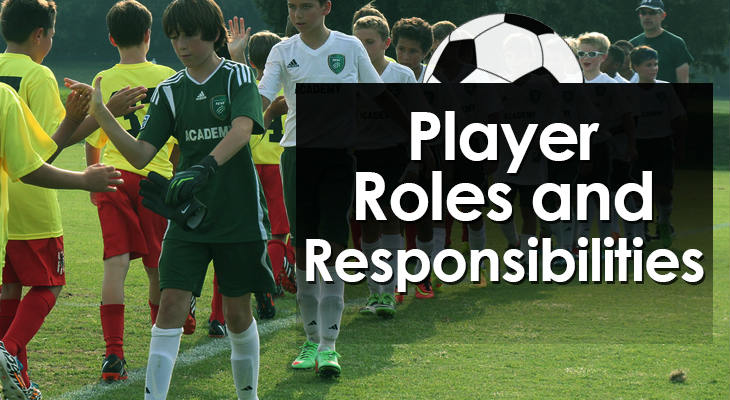
Goalkeeper
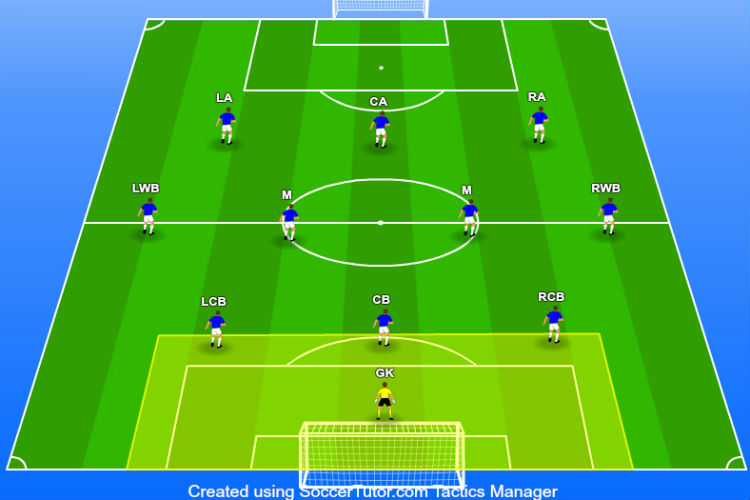
As with all formations, the goalkeeper’s primary objective is to stop the opposition from scoring past them.
In the 3-4-3 formation, however, the goalkeeper has more responsibility as they not only have to save shots but also contribute to the team retaining possession.
This means they have to be calm on the ball and technically capable as they will have more of the ball at their feet than in other formations.
There is also more emphasis on the goalkeeper to communicate in 3-4-3.
With the entire pitch in front of them, they must help the defenders to spot runs and movements, especially during counterattacks.
As well as being a good shot-stopper, the goalkeeper needs to be good on the ball and a vocal presence in the team.
Center Backs
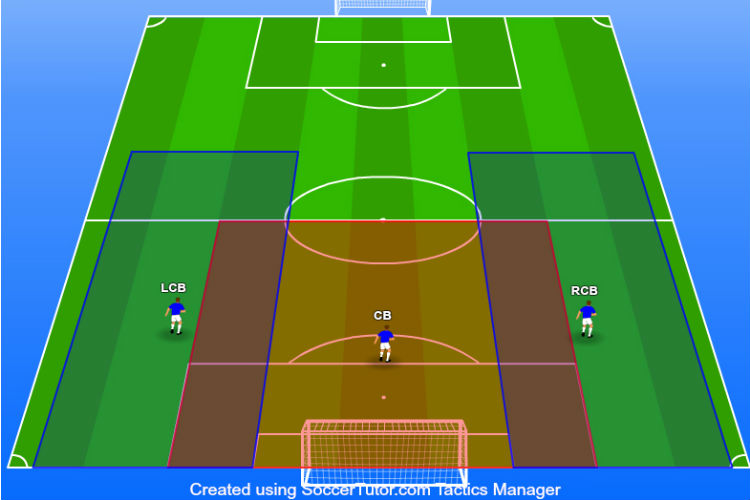
Unlike with other formations, the center backs in a 3-4-3 don’t get much protection from the midfield.
Therefore, each defender should have high-level 1v1 defending abilities and a technical defensive skill set.
Their timing must be on point, ensuring they only commit to a tackle when the time is right.
The back three must play as a unit and maintain a strict defensive line.
A high soccer IQ and a distinct ability to read the game are key to snuffing out attacks and limiting goalscoring opportunities.
Pace, power, and strong aerial abilities are also important when defending against teams who play direct.
In a 3-4-3, the center backs will also be called upon to keep the ball and recycle possession.
As well as having solid defensive skills, they should be good passers and technically sound with the ball at their feet.
Wingbacks
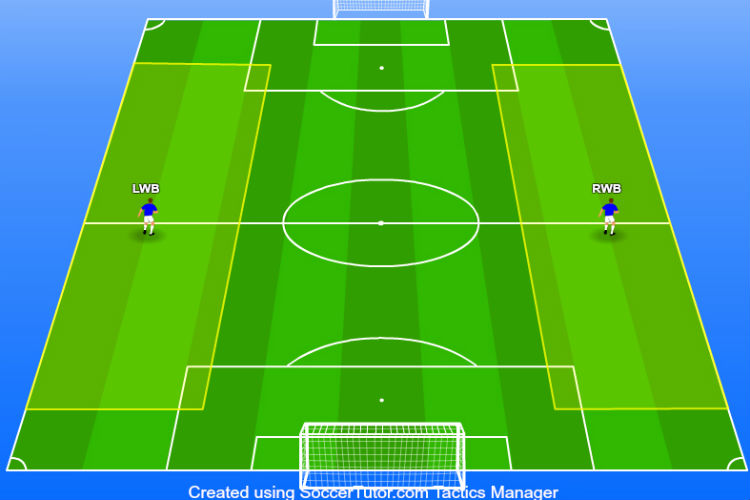
The wingbacks are the fittest players on the team and it is their responsibility to bomb up and down the pitch for the whole duration of the match.
They need to be fast, mobile, and tactically astute to ensure the formation is a success.
The team’s width relies on these players and if they do not fulfill their role, the whole team can become unbalanced.
By staying out wide, they afford more space to the central midfielders and front three, enabling more fluid attacking phases.
The best wingbacks are strong dribblers and capable of beating a defender 1v1. But, their real utility in offense comes in the form of chance creation.
Wingbacks must take chances in the final third and look to hit the byline to get dangerous crosses into the forwards.
It’s not all-out attack, however. Wingbacks are also crucial in defense.
Out of possession, they must track back, defend wide areas, and cover the back post.
Perhaps the biggest threat to a 3-4-3 is on the wings when the wingback is out of position so they must know when to take risks and when to retreat.
Center Midfielders
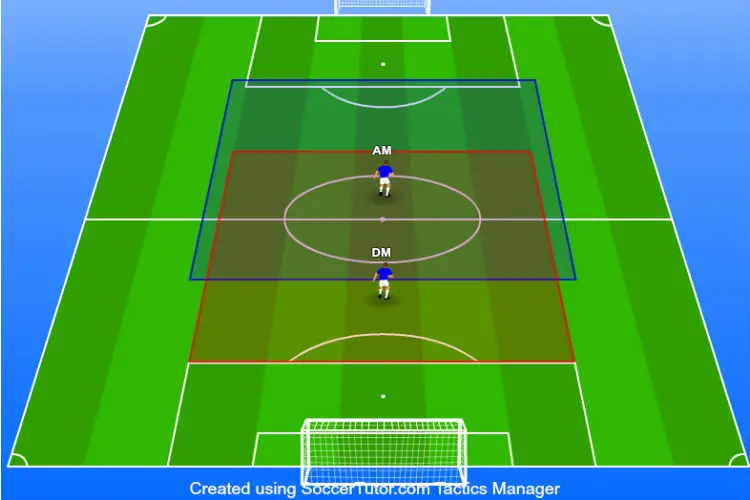
In a flat midfield, one midfielder is usually more attacking while the other is more defensive.
Both of them, however, have to contribute offensively and defensively to the team’s play and they need to be tactically disciplined to make the formation work.
These players have to connect well with their teammates and exert their influence on the match by controlling the possession.
The more defensive-minded midfielder disrupts the opponent’s attacks and supports the defense by dropping in to fill any spaces left by the center backs or wingbacks pushing forward.
They need to be aware of open spaces that the opposition can attack and fill in when necessary. This means they have to read the game well.
Since the center midfield roles involve both attack and defense, a good work rate and high-level fitness are required.
Having a well-rounded on-the-ball skill set is mandatory to be successful in these roles.
Front Three
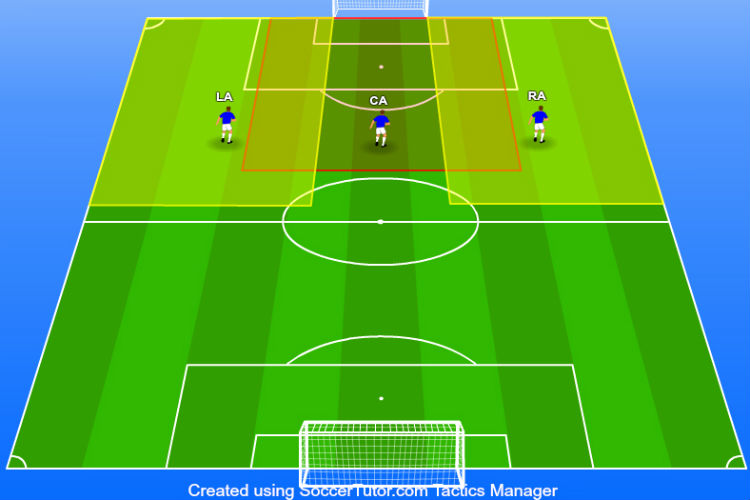
One of the great things about the 3-4-3 formation is the number of ways that the forwards can line up.
The most popular ways to line up your front three are:
- Two attacking midfielders behind a striker
- False 9 with two advanced wingers
- Flat three with two wingers and a striker
More often than not, when you see a 3-4-3, the team plays with two CAMs and a striker.
The CAMs occupy space between the midfield and defensive lines, making them difficult to mark.
From here, they have multiple attacking angles to create from.
Your CAMs should drift into wide areas to stretch the defense and link up with the wingbacks.
However, when the ball is wide, they should also hit the penalty box looking to get on the end of crosses.
With a false 9, the central striker comes deep, taking up areas in “no man’s land”, which can confuse the opposition.
The idea is to drag the center backs out of position, leaving space in behind for the wingers to run into.
Jurgen Klopp’s Liverpool used Roberto Firmino as a false 9 to great success, with Sadio Mane and Mo Salah playing on either side.
Firmino was essentially a playmaker and acted as the catalyst for virtually all of Liverpool’s attacks.
Finally, a flat front three operates the same as any other with two wingers on either side of a center forward.
How to Beat a 3-4-3 Formation
When facing a team in a 3-4-3 formation, it’s easy for the game to escalate into a gunfight.
With so many attacking players, this is not the type of match you want.
So, it’s important that you take a disciplined and strategic approach to nullify their attack and create openings of your own.
While the 3-4-3 is by no means easy to face, there are proven ways to succeed.
Below are three keys to success against a 3-4-3 formation.
1. Focus on the Wings
The defensive focus of the 3-4-3 is central, leaving space on the wings to exploit.
Even if the team has strong wingbacks, they can’t be in two places at once.
So, rather than going toe-to-toe in the middle of the park against a 3-4-3, focus on building attacks from the wings.
Set out with attacking fullbacks and wingers, perhaps in a 4-3-3 shape, and build attacks from wide areas.
2. Use a Double Pivot
Dual number 10s are a handful and simply put, there is no easy way to handle them.
One effective way to limit their impact is to deploy a double pivot in midfield and “man-mark” each of the 10s.
While this may require you to play defense-minded midfielders, your main attacking outlets are on the wings so it can fit your strategy.
Double pivots can work in a range of formations. Again, the 4-3-3 is a useful one against this shape.
3. Counter Attack
If you have a strong counter-attacking team, you can enjoy tremendous success against a 3-4-3.
Since the 3-4-3 commits so many players to attacks, it is vulnerable in transition once you turn the ball over.
So, don’t be afraid to absorb some pressure, set traps in your defensive third, then spring quickly on the counterattack.
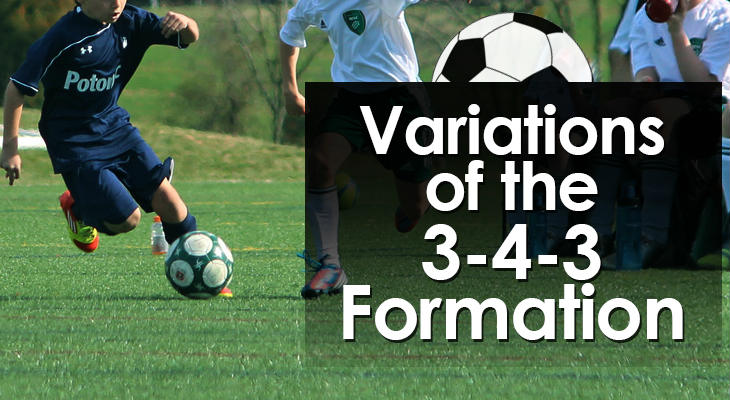
3-4-3 Formation Variations
The beauty of the 3-4-3 formation is that it can easily be adapted on the pitch depending on how the game is going, the scoreline, and how the players are playing.
Although I’ve touched on some of the options you have, there’s one variation that needs a little more detail.
Diamond Midfield
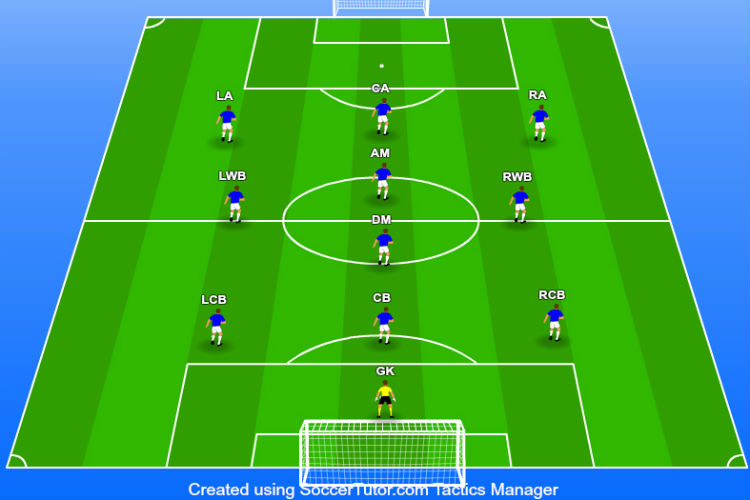
While teams usually line up in a flat midfield with the wing-backs on either side of the central midfielder, some teams prefer to play with a diamond in the middle.
In this formation, one midfielder plays the holding role, with a left and right midfielder in front of them and an attacking midfielder at the tip of the diamond behind the three forwards.
From here, the holding player sits back and covers any positions left open by players advancing while the left and right midfielders help control possession and have to contribute both offensively and defensively.
They are narrower than wing-backs though and there is less emphasis on them to push out wide. This can be a problem at times as it can lead to a lack of width in the team and congestion in the centre of the pitch.
The attacking midfielder obviously takes on more of the attacking responsibility and contributes less to the defensive side of the game.
Conclusion
The 3-4-3 formation is incredible to use if you can get it right.
Every single player needs to know their job and what’s expected of them.
It is a very demanding formation both physically and mentally and the players have to be on top of their game to make it a success.
In this attacking formation, you will have a fun time playing offensive football.
And if you attempt the formation with younger players it will help them to gain a greater understanding of the beautiful game and how each and every one of their teammates are crucial to the success of the team.
Further Reading: 5 Soccer Formations Explained (Full Guides with Images)

